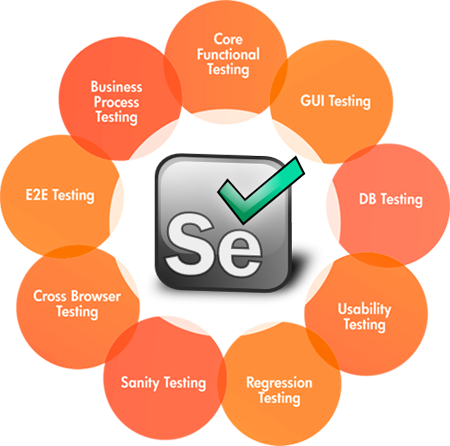Introduction
In 2004, Jason R. Huggins invented Selenium. It was known as JavaScrilampt functional tester (JSFT) during its early years. It evolved as an open-source browser-based integration test framework, which was originally developed by Thoughtworks. JSFT was a javascript (HTML) during its early years, which was designed to make testing as simple as possible. It worked in Internet Explorer 6/7, Firefox.8+, Safari, and other browsers. If you want to advance your career as an automation tester with extensive Selenium course, you can finally learn to complete multiple tasks in the least amount of time and have a thriving career.
Selenium is a testing framework designed specifically for web applications and many software testing services use it regularly nowadays. It’s both portable and cross-platform compatible. The Selenium framework can be written in a variety of programming languages and can run on a variety of browsers. Selenium test scripts are written in programming languages like Java, Python, and Net. A major part of its code is written in HTML and can be implemented on various operating systems such as Windows, Mac, etc. User Acceptance tests (UAT) actively used Selenium as a first choice. User acceptance tests are tests that are mainly performed by user clients to accept a software system before the software is ready for production. UAT can be considered an integral part of software production because developers develop software based on their intuition and understanding. UAT allows them to implement changes that might not have been communicated during the software development cycle.
Components of Selenium
Selenium is an Integrated Development Environment (IDE) suite that includes all of the tools needed to create tests. This development suite makes it simple for users to create tests. For editing and recording tests, Selenium uses the Firefox extension.
Selenium IDE Features
Some important features of selenium IDE are listed as follows:
- It features easy and manageable debugging and helps in setting breakpoints
- It helps in recording and playback of tests
- The suite is provided with auto-fill and auto-completion functionality of all selenium commands
- It can automatically declare the title of every page
- It has inbuilt support for user extensions such as .jr file
Licensing information
As previously stated, Selenium is an open-source software that was first released under the Apache 2.0 license and can be used for free.
What is an automation test?
Software test automation is an intrinsic part of the software development process. Software testing is a procedure for identifying errors and bugs in previously developed software. Testing is directly related to providing customers with software quality assurance.
It’s not wrong to say that testing is limited only to find bugs and defects in a system because real-time testing cannot guarantee software’s full functionality. Testing can be carried out manually or with the help of automation tools. Selenium is one of the automation tools we’ll be discussing here. Manual testing has only a few benefits when compared to testing that are performed by using automation tools.
Manual testing is prone to human errors and mistakes because the testers who perform these tests are humans.
Source: A Practitioner’s Guide to Test Automation using Selenium by Ashish Mishra, Aditya garg
Automated testing entails the creation and execution of tests that are run in the background with a close resemblance to desired outcomes. Because testing is a repetitive task, it can be performed more efficiently with the use of automation tools.
A fun fact trick of google is i’m feeling curious.
Benefits of automated tests
Automated testing cannot replace manual testing, as it is an overhead burden in overall product testing. Automated testing is expensive and requires some time-tested techniques along with automated test strategies to be followed to increase its cost-effectiveness. Business goals and objectives must be defined to implement automated testing. Because automated test strategies differ for each project, potential risk factors, as well as the test environment should be identified ahead of time. With the implementation of automated test strategy corresponding measures should be used to track and ensure whether or not automated testing is meeting the desired goals and objectives.
Best practice for Automation testing
Implementing successful use of automated testing ensures a good level of Return on Investment. A handful of points should be considered to obtain the best possible ROI.
- Manual tests may be required prior to the execution of automated tests in some cases. Automated tests are not always cost-effective or appropriate.
- Not all testing environment favors automated testing.
- The test process should be clearly defined with a definite architectural approach and supporting design to facilitate automation testing.
- Test automation should be robust ensuring appropriate levels of reliability.
- A repeated automated test should be performed to attain greater levels of quality.
- Test automation conduct and standard should be well defined in advance.
- Automation testing should be well documented, planned, and should be measured at regular intervals
Test automation environment
Selenium IDE works in collaboration with the Firefox plugin that records and playback interactions with browsers. Firefox plugin helps a user to script simple scripts or to create Selenium RC scripts. The minimum recommended version of IDE is 1.0.10
Selenium RC
Selenium Remote control (RC) is an updated testing tool that helps the user to create automated web application tests in different programming languages. Selenium RC works on any browser that is compatible with javascript.
Selenium is regarded as the most promising and reliable framework for automated testing. Selenium was released under Apache 2.0, which made it open-source hence contributed to its success on a global level. Being an open-source program facilitates professionals all over the world to download it for free and to test their web applications without any restrictions.
Selenium web driver
Selenium web driver is an enhanced version of Selenium RC. Like Selenium RC this web driver was also designed to have multiprogramming language compatibility. It was specially designed to overcome to the architectural limitation of selenium RC. Selenium comes with cross-browser compatibility as well.
Top myths in Selenium Testing
- Selenium has restricted features because it is an open-source software
It’s a popular belief that proprietary paid software provides better features and facilities when compared to open-source programs. However, this assumption may be wrong in the case of Selenium since it has huge online communities where professionals and QA contribute their major work among the global users. Members have access to all of the required features from these communities; defying any stereotype that claims Selenium to have limited capabilities.
- Selenium cannot be regarded as an enterprise
Because Selenium is an open-source framework, most users believe that it cannot be treated as a business. This belief forces the users to buy other expensive third-party testing tools. This belief is completely false, as Selenium was created by the Apache Software Foundation (ASF), one of the largest nonprofit corporations in the world, which supports several open-source projects run by professionals all over the world. Selenium has all the features and benefits just like any other enterprise that helps users in making testing convenient.
- No software updates for bugs
Most Software professionals around the world believe that open-source software lacks periodic bug fixes and important updates when compared to their premium counterparts. This is certainly not true, because Selenium being an open-source software has its online community, which contains a collaboration of many other professionals from all around the world discussing updates and other possible improvements to the product.
Open-source communities help individuals that are participating to share new innovative ideas. These ideas and innovations can be treated as new updates, which fix bugs and errors and improvise the overall qualities of the product. Selenium has a comprehensive community with a large number of individuals participating and sharing new ideas.
- Security at risk
Creating software is not possible with the help of human interaction through a user interface. Any kind of machine-human interaction involves sharing of information in form of instructions or any kind of personal data. To avoid user data to get exploited, software developers should prioritize strategies that encrypt user data.
It’s a common belief among users that open-source software does not guarantee the best security. This does hold true for some open-source software around the market but not in the case of Selenium because Selenium is proprietary software of a reputed open-source organization. Therefore, a software tester must get rid of this kind of stereotypical thoughts, which can help them to build high-quality software with optimized costs. Another feature of Selenium is that it can work equally well on various web-based virtual device simulators such as LambdaTest.
Browser stack enables cloud simulation of real devices helping the user to test their web applications using selenium. Despite these myths, Selenium has been successful in maintaining its popularity among large masses.
Conclusion
Changing environments in software development have compelled software testers to invent new ways to keeps bugs and errors out of the window. This requires the implementation of new well-planned detailed strategies in software testing. In recent years, Selenium has proved to be a stepping-stone in the world of software testing.
Apart from these valuable benefits, Selenium has certain shortcomings as well such as; Selenium can only be used to test web applications. Testing a desktop application doesn’t seem possible with it.
There is no dedicated customer support on Selenium. The users have to solely rely on its online communities. Image-based testing is not possible in Selenium. The tester has to rely on third-party software such as Sikuli for image testing support.
You can begin your Selenium Automation Testing with LambdaTest by performing Selenium testing on a scalable, secure, and reliable cloud-based testing grid that runs across 2000+ desktop and browser environments.











